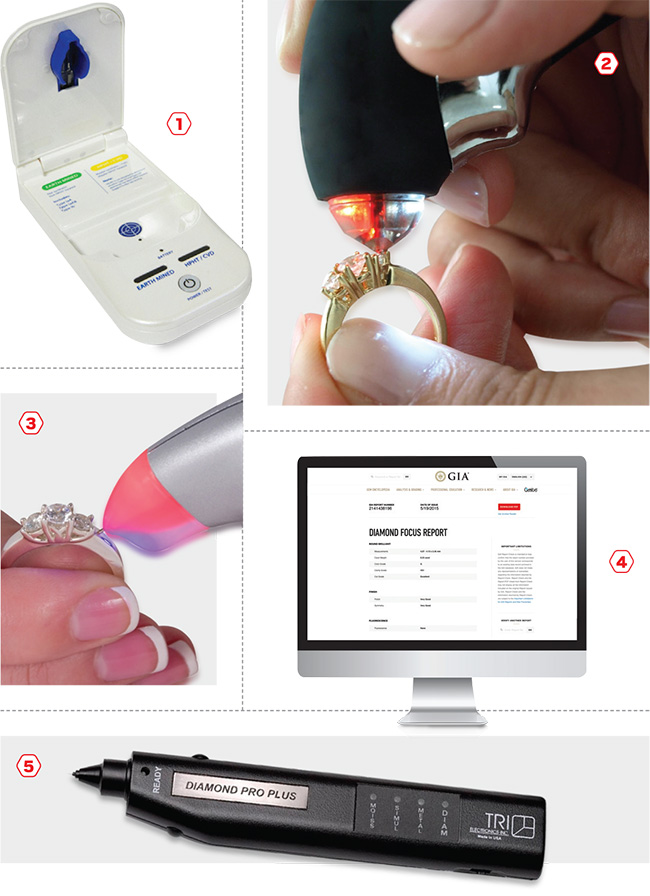Testing diamonds has become a difficult science when the competition may outsparkle it, as does moissanite, or even call itself a diamond, such as lab-grown ones do. But now there are diamond-moissanite testers that light the area being tested, warn you when your tester is touching metal, can speak in various languages and can be charged or carry a battery pack. “It’s like anything else — it’s your reputation,” says Danny Kessler of Sy Kessler Sales. “How important is your credibility and your confidence? I know diamond buyers and diamond cutters who have bought diamond-moissanite testers.” With the growing number of lab-grown diamonds as well, jewelers need to take testing much more seriously, warns Keith Sessler, president of Starstruck: “The whole industry is about to drastically change.”

1. Gemlogis Taupe diamond identifier (around $590) is able to distinguish between human-made and earth-mined loose diamonds and works on short-wave ultraviolet (SWUV) checks. The stone is placed in the equipment, and results are nearly instant. It operates on a rechargeable lithium battery.
2. The GemOro 0751 UltraTester II (around $200) simultaneously distinguishes between diamond, moissanite, CZ and white sapphire, and has a metal warning signal. Bright white LED illuminator inspection light helps guide the user; a bar graph Indicator indicates the type of stone detected and center zone reveals the extent of the stone’s conductivity.
3. The Testerossa diamond-moissanite tester (around $300). Its red light warns the tester that the tip is touching metal. It lights different colors for diamonds, moissanite and colorless sapphire or simulants.
4. The Gemological Institute of America (GIA) offers laboratory testing of loose diamonds, including whether the stones are natural or created. The Diamond Focus Report ($20 to $22) comes as an online record; the most expensive report, the Dossier, includes a printed form and a laser GIA identification on the stone.
Advertisement
5. Tri Electronics Diamond Pro (around $190) prides itself on fast startup and instant test recovery. It sounds when the test is complete, showing the type of stone via light color.
Points to Consider
Lab-grown diamonds. With an old-style diamond tester, lab-grown diamonds will test as diamonds because the chemical composition is nearly the same — with the exception of a slight nitrogen percentage difference. “My advice is to get a tester that will separate lab-grown diamonds,” says Keith Sessler, president, Starstruck LLC. The only tester on the market right now that will separate lab-grown diamonds is the Taupe by Gemlogis, Sessler says.
The battery. “A rechargeable battery works nicely when you need to take it with you,” says Michael Radomyshelsky, VP, Tri Electronics Inc. Its rechargeable battery is good for 500 charges and discharge cycles.
The tip. “Spring-loaded tips have some advantage in that they’re more sensitive. They use a thinner wire, and they offer a much faster warmup time,” says Radomyshelsky.
Ergonomics. The top-of-the-line Testerossa, for example, is curved so you have a natural line of sight to the stone. — Danny Kessler, co-owner, Sy Kessler Sales, Dallas, TX.
Outsourcing. GIA recently introduced the Diamond Focus Report as a cost-effective way for jewelers and others to assess smaller diamonds — weighing between 0.15 and 0.29 carats, says Tom Moses, senior VP for laboratory and research for the GIA. “Confirmation that the diamond is natural is a key part of the service,” he says.
Advertisement

Retailer Take
Jessica Brumley
Appraiser, Sartor Hamann Jewelers, with three stores in Lincoln and Grand Island, NE
- “I like being able to have one unit, a diamond-moissanite tester, instead of two. It’s just a matter of convenience.”
- “Overall, reliability is most important in a tester. You get what you pay for.”
- “I have a hard-tip tester. I’ve never had any problems with it. ”
- “We do have a lot of people who want appraising for insurance purposes. Also, I do it for estate planning purposes — to help people find out the value of what they’re including or to find out a fair market value for the estate executor.”
- “Once in a while I do go to a client’s home or business. For that, the battery-operated tester is convenient.”
- “Most of the lab-created diamonds I’ve seen have laser inscriptions identifying them, but if we weren’t sure, and wanted to know, we’d send them to GIA or AGS for testing. We don’t have a tester that separates them. ”
This article originally appeared in the February 2016 edition of INSTORE.